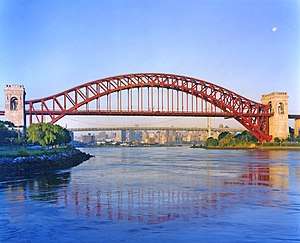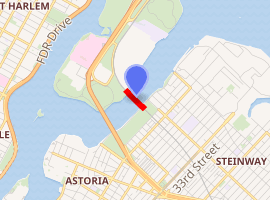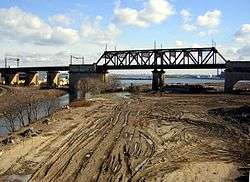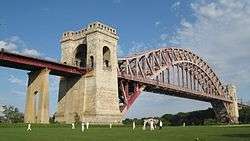Hell Gate Bridge
The Hell Gate Bridge, originally the New York Connecting Railroad Bridge[2] or the East River Arch Bridge,[3] is a 1,017-foot (310 m)[lower-alpha 1] steel through arch railroad bridge in New York City. The bridge carries two tracks of Amtrak's Northeast Corridor and one freight track across the Hell Gate, a strait of the East River, between Astoria in Queens, and Randalls and Wards Islands in Manhattan.
Hell Gate Bridge | |
|---|---|
 Hell Gate Bridge in 2008, with the Triborough Bridge and the Upper East Side skyline in the background | |
| Coordinates | 40.7824°N 73.9217°W |
| Carries | Amtrak Northeast Corridor; CSX/CP (D & H) freight |
| Crosses | Hell Gate of the East River |
| Locale | Queens and the Bronx in New York City via Randall's and Wards Islands |
| Owner | Amtrak |
| Maintained by | Amtrak |
| Characteristics | |
| Design | Through arch bridge |
| Material | nickel-manganese steel |
| Total length | 17,000 feet (3.2 mi; 5.2 km) |
| Width | 100 feet (30.5 m) |
| Longest span | 978 feet (298 m) |
| Clearance below | 135 feet (41.1 m) |
| Rail characteristics | |
| No. of tracks | 3
|
| Track gauge | 4 ft 8 1⁄2 in (1,435 mm) standard gauge |
| Structure gauge | AAR |
| Electrified | 12.5 kV 60 Hz AC catenary (Northeast Corridor only) |
| History | |
| Designer | Gustav Lindenthal |
| Engineering design by | Harold W. Hudson |
| Constructed by | American Bridge Inc. |
| Fabrication by | American Bridge Company |
| Construction start | 1912 |
| Construction end | 1916 |
| Opened | March 9, 1917[1] |

| |
 Hell Gate Bridge Location in New York City | |
The arch across the Hell Gate is the largest of three bridges that form the Hell Gate railroad viaduct. An inverted bowstring truss bridge with four 300-foot (91.4 m) spans crosses the Little Hell Gate, a former strait that is now filled in, and a 350-foot (106.7 m) fixed truss bridge crosses the Bronx Kill, a strait now narrowed by fill. Together with approaches, the bridges are more than 17,000 feet (3.2 mi; 5.2 km) long.[4] The designs of the Tyne Bridge in Newcastle, England and the Sydney Harbour Bridge in New South Wales, Australia were derived from the Hell Gate Bridge.[5]
History



The bridge was conceived in the early 1900s to link New York and the Pennsylvania Railroad (PRR) with New England and the New York, New Haven, and Hartford Railroad (NH).[6] In June 1906, the NH applied for and received a franchise to operate trains from the northeastern suburbs of New York City to Pennsylvania Station in Midtown Manhattan, built by the PRR. The New Haven would be able to accomplish this by constructing a spur from the four-track New Haven Railroad and New York Central Railroad main line in the Bronx (these railroads are now respectively the modern-day New Haven Line and Harlem Line of the Metro-North Railroad). The spur, now the Port Morris Branch, would split north of Melrose station in the South Bronx, then merge with the Harlem River and Port Chester Railroad (HR&PC; now part of the Northeast Corridor) just north of the Harlem River. The HR&PC would pass from the Bronx to Queens via the Hell Gate Bridge, then continue south through Queens, eventually connecting to the East River Tunnels and Penn Station.[7] As part of the plan, the Hell Gate Bridge would carry four tracks, which would connect to the NH's four-track lines on either side of the Hell Gate.[8]
Construction was overseen by Gustav Lindenthal, whose original design left a gap of 15 feet (4.6 m) between the steel arch and the masonry towers. Fearing that the public assumed that the towers were structurally integral to the bridge, Lindenthal added aesthetic girders between the upper chord of the arch and the towers to make the structure appear more robust.[9] The original plans for the piers on the long approach ramps called for a steel lattice structure. The design was changed to smooth concrete to soothe concerns that asylum inmates on Wards and Randall's islands would climb the piers to escape.[9]
The engineering was so precise that when the last section of the main span was lifted into place, the final adjustment needed to join everything together was just 5⁄16 inch (7.9 mm). Construction of the Hell Gate Bridge began on March 1, 1912 and ended on September 30, 1916.[10] The bridge was dedicated and opened to rail traffic on March 9, 1917,[1] with Washington–Boston through trains first running on April 1.[11] It was the world's longest steel arch bridge until the Bayonne Bridge opened in 1931.[12]
During World War II, its economic value made it a target of the Nazi sabotage plan known as Operation Pastorius.[13]
In the 1990s, the bridge was repainted for the first time since it opened. It was painted a deep red called "Hell Gate Red". Due to a flaw in the paint, the red color began to fade before the work was completed, leading to the bridge's currently faded, splotchy appearance.[14]
Usage
Tracks
The bridge originally carried four tracks, two each for passenger and freight, but one freight track was abandoned in the mid-1970s. At one time, all tracks were electrified with the 11 kV, 25 Hz overhead catenary, the standard of NH and PRR. The passenger tracks have been electrified since 1917, and the freight tracks from 1927 to 1969, using Amtrak's 25 Hz traction power system.
Fares
Some passengers paid to use the bridge; some fares over the bridge were higher than the usual fares for the same mileage.[15] In September 1940, coach fares were two cents per mile, so Boston to either Grand Central Terminal or New York Penn Station was the same amount, at $4.60, even though only trains to Penn Station used Hell Gate. But Boston to Washington, D.C. was $10.00 instead of the expected $9.10; for a few decades after 1920, 90 cents was added to all fares via Hell Gate except tickets to New York itself. In April 1962, New Haven to New York cost $3.43, New York to Philadelphia cost $3.91, and New Haven to Philadelphia was $8.24. (1962 fares do not include federal tax, then 10 percent.)
Current use
The bridge and structure are owned by Amtrak, and lies in the New York Terminal District, part of its Boston to Washington, D.C. electrified main line known as the Northeast Corridor. The bridge's two west most tracks are electrified with 12.5 kV 60 Hz overhead power and are used by Amtrak for Acela Express and Northeast Regional service between New York and Boston. In September 2009, the Metro-North Railroad's Train to the Game services, operated by New Jersey Transit from key stations on the New Haven Line to Secaucus Junction, started using the bridge during every Sunday Giants or Jets NFL game at MetLife Stadium. However, this service was suspended in 2017.[16]
The bridge is also part of the New York Connecting Railroad, a rail line that links New York City and Long Island to the North American mainland. The third track forms part of the CSX Fremont Secondary and carries CSX, Canadian Pacific and Providence & Worcester Railroad freight trains between Oak Point Yard in the Bronx and Fresh Pond Yard in Queens, where it connects with the New York and Atlantic Railway.[17][lower-alpha 2]
In September 2009, Metro-North revived its planning efforts for its Penn Station Access project, which would use the Hell Gate Bridge to connect the New Haven Line to Penn Station.[18] Such a service would terminate at Penn Station on platforms freed up by the planned completion of the Long Island Rail Road's East Side Access tunnel to Grand Central Terminal, which is scheduled for completion in late 2022.[18] If the plan is implemented, through-running between the New Haven Line and New Jersey Transit would be possible, linking business centers in Connecticut and New Jersey while providing access to Newark Liberty International Airport.[19] The draft Environmental Assessment was originally expected to be available for public review in late 2018.[20] Subsequently, in January 2019, it was announced that Amtrak and the MTA had reached an agreement regarding track usage rights, and $35 million was approved for initial engineering design work.[21][22][23] The MTA expected to begin service on the line by 2023.[24]:53
See also
- List of bridges documented by the Historic American Engineering Record in New York
- Oak Point Link, connecting rail line in the Bronx
- Rail freight transportation in New York City and Long Island
- Michael Sergio, who wrote Under Hellgate Bridge (2000)
References
Notes
- The arch is 1,087.5 feet (331.5 m) measured center to center of the concrete towers.
- Long Island's railways only have two direct connections to the mainland. The other link to the mainland is via Penn Station, which goes through Manhattan first to get to the mainland. There is also a rail freight barge service between Brooklyn and New Jersey operated by New York New Jersey Rail, LLC.[17]
Citations
- Thom, William G.; Sturm, Robert C. (2006). The New York Connecting Railroad. Long Island-Sunrise Chapter, National Railway Historical Society. p. 46. ISBN 9780988691605.
- Schneider, Daniel B. (March 19, 2000). "F.Y.I." The New York Times. Retrieved January 23, 2011.
- Gruson, Lindsey (November 30, 1991). "Long Unlucky, Rail Bridge Hits $55 Million Repair Jackpot". The New York Times. Retrieved January 23, 2011.
- Staff. "Growing a Bridge From Both Ends", p. 769, The Literary Digest, Volume 51, No. 14, October 2, 1915. Accessed July 7, 2016. "The whole length of the structure (arch and two approaches), from abutment on Long Island to abutment in the Bronx, is 17,000 feet, or considerably over three miles."
- "Tyne Bridge". BBC Inside Out. September 24, 2014. Retrieved December 28, 2016.
Tyne Bridge was designed by Mott, Hay and Anderson... in turn derived its design from the Hell Gate Bridge
- Capo, Fran. Myths and Mysteries of New York: True Stories of the Unsolved and Unexplained, p. 71. Rowman & Littlefield, 2011. ISBN 9780762768974. Accessed July 7, 2016. "In the early 1900s, a plan was conceived for a bridge that would make Hell Gate even more accessible and would also link the New Haven and Pennsylvania railways, creating direct passenger service from New York to Boston."
- "NEW HAVEN ROAD TO USE PENNSYLVANIA TERMINAL; Applies for Leave to Avail Itself of Port Chester Tracks. TO ENTER CITY BY TUNNEL Rapid Transit Board Directs That Connecting Railroad Franchise Be Taken Up Without More Delay". The New York Times. June 22, 1906. Retrieved May 22, 2018.
- Mills, William Wirt (1908). Pennsylvania Railroad tunnels and terminals in New York City. Moses King. Retrieved May 26, 2018.
- Anderson, Steve. "Hell Gate Bridge". NYCRoads. Retrieved April 13, 2010.
- Hell Gate Bridge at Structurae
- "HELL GATE SERVICE APRIL 1.; Through Trains from Washington to Boston Will Be Started Then". The New York Times. March 14, 1917. Retrieved February 29, 2016.
- "Best Places to See NYC's Bridges", New York City Department of Parks and Recreation. Accessed April 18, 2016. "When it opened in 1931, the Bayonne Bridge surpassed the Hell Gate to become the longest steel arch bridge in the world and remained so for 45 years."
- MacDonnell, Frances (November 2, 1995). Insidious Foes: The Axis Fifth Column and the American Home Front. Oxford University Press. p. 131. ISBN 0-1950-9268-6.
- Kilgannon, Corey (March 8, 2012). "A Bad Impression Outlasts a Bridge's New Paint". New York Times. Retrieved January 10, 2015.
- Staff. "I.C.C. Orders Inquiry on 90c Extra Fare On Certain Trips Over Hell Gate Bridge", The New York Times, December 20, 1951. Accessed July 7, 2016.
- Silberstein, Judy (September 24, 2009). "Football Fans Take New Train to the Game". Larchmont Gazette. Retrieved July 3, 2011.
- "Railroads in New York - 2016" (PDF). New York State Department of Transportation. January 2016. Retrieved December 9, 2018.
- "Penn Station Access Study". Metropolitan Transportation Authority. September 2009. Retrieved April 12, 2008.
- "Connecticut Presentation (2013)" (PDF). mta.info. Metropolitan Transportation Authority. March 2013. Retrieved January 27, 2017.
- "Penn Station Access Background". web.mta.info. Metropolitan Transportation Authority. July 2018. Retrieved July 4, 2018.
- "MTA | news | Project to Build Bronx Metro-North Stations Advances". www.mta.info. Retrieved January 22, 2019.
- "Metro-North riders will finally get Penn Station access". am New York. January 22, 2019. Archived from the original on January 23, 2019. Retrieved January 23, 2019.
- Spivack, Caroline (January 22, 2019). "MTA to build new Metro-North stations linking Bronx to Penn Station". Curbed NY. Retrieved January 23, 2019.
- "Capital Program Oversight Committee Meeting" (PDF). Metropolitan Transportation Authority. April 2019. Retrieved January 18, 2019.
- Location: "Wikimapia - Let's describe the whole world!". wikimapia.org.
- 2007 photo: Amtrak Railway Bridge on Randall's Island NYC (Little Hell Gate) | Flickr – Condivisione di foto!. Flickr.com (September 1, 2007). Retrieved on August 2, 2013.
Further reading
- Cook, Richard J. (1987). The Beauty of Railroad Bridges in North America – Then and Now. San Marino, California (USA): Golden West Books. ISBN 0-87095-097-5.
- Hell Gate Bridge at Structurae
- Historic American Engineering Record (HAER) No. NY-88, "New York Connecting Railroad, Hell Gate Bridge, Spanning East River, Wards Island & Astoria, New York, New York County, NY", 5 photos, 1 photo caption page
External links
